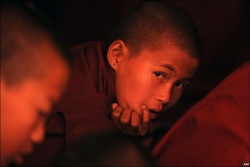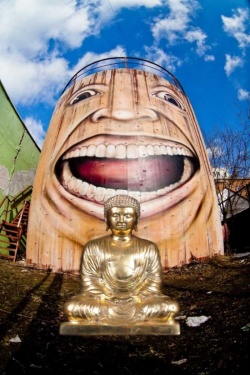Western Explorers in Tibet
Tuo Chaoqun’s Ph.D. dissertation, [[Jin xiandai zai Anduo (Amdo) de Xifang ren ji qi lüxing shuxie 近现代在安多 (Amdo) 的西方人及其旅行书写, which the author liberally translates as Amdo in the Eyes of the Yellow Hair:
A Study of the History of the Western Exploring in Northeastern Tibetan Plateau (2012) is an inclusive and well-structured survey of Western explorers and missionaries who lived and/or traveled in the Amdo region of Tibet between the mid-19th century and mid-20th century.
Tuo examines works of explorers and missionaries such as Nikolay Przhevalsky (1839-1888), who traveled in Central Asia and Northwest China in the 1870s and ’80s; William W. Rockhill (1854-1914), who made two expeditions into western China, Mongolia and Tibet in the 1880s; Joseph F. Rock (1884-1962), who lived mostly in Yunnan (China) and Kham (Eastern Tibet) between 1922 and 1949; and Robert B. Ekvall (1898-1983), who was born in China, and spent the majority of the first forty years of his life in Gansu (China) and Amdo.
Tuo also focuses on activities of missionary organizations such as the China Inland Missionary and the Christian and Missionary Alliance. Written in response to the existing bias among many Chinese scholars and students in the field of Tibetan Studies against works by Western missionaries and travel writers, Amdo in the Eyes of the Yellow Hair seeks to reintroduce these writers to its Chinese audience by emphasizing the value of their works as potential primary materials for scholarly research instead of their intrinsic flaws and inevitable absurdities as products of 19th-century Orientalism.
Tuo’s dissertation responds to many previous academic works in both Chinese and Western languages. As for studies in Western languages, Tuo synthesizes and supplements Michael Taylor, Jacqueline Thevenet, S.B. Sutton, Mabel Hobart Cabot, as well as Orville Schell’s works.
As for studies in the Chinese language, Tuo critically incorporates important studies carried out by prominent scholars such as Xu Er’jing and Fang Jianchang. As Tuo mentions in the introductory chapter, his evaluation of Western writers and their works on Amdo between the mid-19th and mid-20th century is not only more systematic in terms of the structural framework, but also more balanced and neutral in terms of value judgment than many previous academic pieces (p. 4-6).
The first section of Amdo in the Eyes of the Yellow Hair is a general introduction and overview of key figures, organizations, activities, and written accounts involved in the exploration of Amdo in the 19th and 20th century. In the second section, Tuo moves on to a much more detailed and thorough examination of the most important individuals and their written accounts.
In the concluding chapter, Tuo situates these authors and their works within the historical context of global colonialism in the mid-19th and mid-20th century and provides his reader with a number of insightful suggestions for understanding, evaluating, and utilizing Western travelers and missionaries’ writings on Amdo.
Tuo notices that the mainstream anti-Western, anti-colonial nationalist discourse sanctioned by the People’s Republic of China in the last sixty years has obstructed many Chinese scholars from viewing Western travel writers and missionaries’ writings objectively. For decades, the majority of scholarly evaluations of these works focus solely on aspects such as geological and botanical investigations, while social, economic, cultural, and anthropological surveys have been largely dismissed.
At the same time, Tuo also notices the phenomenon that many scholars in China, while focusing on European and Russian travelers’ works, tend to overlook American individuals’ writings, since a large number of American authors were also missionaries, and the study of Christianity and missionary activities in China is still in its nascent stage.
After comparing Western travel writers and missionaries’ pieces with existing Chinese scholarly investigations on Amdo, Tuo points out that a more meticulous examination and critical incorporation of Western sources would not only enrich scholarly researches on Amdo in historical and social aspects, but also direct Chinese researchers towards a number of potential topics such as the urbanization of frontier towns and the organization of Tibetan Buddhist monastic institutions in the 19th and 20th centuries.
After going through a large quantity of Chinese-language materials such as published obituaries and local celebrities’ autobiographical accounts, Tuo tries to portray these Westerners through the perspective of the local people who had direct interactions with them, and seeks to challenge the established view within China that stigmatizes and dismisses the majority of Western travelers and missionaries between the mid-19th and mid-20th century—such as Rock and R.B. Ekvall—as “foreign spies,” “scheming imperialist agents,” or “thieves of Chinese ancient artifacts,” merely because of their Western backgrounds (p. 290).
While China’s mainstream discourse still demonizes the growing Western presence in Tibet between the mid-19th to mid-20th century, Tuo encourages his reader to think beyond the constraints of this stereotype. In addition to acknowledging Western travel writers and missionaries’ academic achievements and appreciating their philanthropic endeavors, Tuo, at the same time, urges his fellow researchers to pay more attention and make better use of the rich and valuable accounts composed by these Westerners.
Amdo in the Eyes of the Yellow Hair provides the Chinese-reading audience with an inclusive and systematic introduction to the most important Western travelers and missionaries who traveled in and wrote about the Amdo region of Tibet between the mid-19th and mid-20th century. Refraining from value judgments and political evaluations of individuals and works under his scrutiny, Tuo, through his thoughtful and well-researched dissertation, demonstrates that young Tibetan-studies scholars in China are beginning to realize and seeking to challenge their previous generations’ ideologically driven biases.
Huasha Zhang Department of History Yale University Huasha.zhang@yale.edu
Primary Sources
The Annual Report of the Christian and Missionary Alliance, Archive Center of C.M.A. 1888-1950. Robert B. Ekvall documents and Helen Irvin Sawyer and Malcolm Maurice documents at the Archives of the Billy Graham Center at Wheaton College.
Kang Furong 康敷镕, ed. Qinghai ji 青海记 (Documents on Qinghai). 1747. Republished by Zhongguo xibei wenxian congshu bianji weiyuanhui 中国西北文献丛书编辑委员会, ed., in Xibei xijian fangzhi wenxian 西北稀见方志文献 (Rare Gazetteers and Documents on Northwest China). Vol. 55. Lanzhou, Gansu: Lanzhou guji shudian. 1990.
Yang Yingju 杨应琚, ed. Xining fu xin zhi 西宁府新志 (The New Gazetteer of the Xining Prefecture). 1746 Republished by Zhongguo xibei wenxian congshu bianji weiyuanhui 中国西北文献丛书编辑委员会, ed., in Xibei xijian fangzhi wenxian 西北稀见方志文献 (Rare Gazetteers and Documents on Northwest China). Lanzhou, Gansu: Lanzhou guji shudian. 1990.
Dissertation Information Lanzhou University. 2012. 309 pp. Primary Advisor: Yongdrol K. Tsongkha.


